Introduction
This is a report that summarizes the performance of a portfolio of five stocks selected (theoretically) on October 01, 2011, and is disposed of holding up to November 03 302011. The paper covers the performance of the portfolio, stock selection criteria, each stock performance, and the returns of the portfolio for the period. A comparison will be made with the performance of the S&P 500. This analysis is for the purposes of an assignment and cannot be relied upon for investment.
Stock Selection and Portfolio
The stocks selected for this assignment are hat stocks AZZ, CSCO, Ø IBM, MCD, SNX. These stocks are from diversified industries and cut across various industries. In the selection of this portfolio, various factors were considered, including price-earnings ratio, debt ratio, current ratio, the competitive advantage of the companies, and the beta of the company before selecting them. However, it should be noted that risk played an important role in the selection of these companies. The assumption that the direction of the market is estimated with reasonable accuracy has been made. It has been assumed that the given beta is persistent at times of this analysis.
P/E ratio, debt ratio, current ratio, net profit margin.
The companies are explained as AZZ: the company is in the metal fabrication industry together with ISMT ltd. They have a sound financial position being among the best performers in the industry. They have a P/E of 14.21 while market leader industry, Allegheny Technologies Inc. has 26.52 most industry players but it is the largest financial institution (Financeyahoo).
International Business Machines Corp (IBM): this company is among the oldest computer companies in the USA. The company has a good financial report and has P/E of 14.95 and operating profit margin of 20.21%( Financeyahoo. International Business Machines Corp).
Cisco Systems, Inc (CSCO): the company operates in the information technology industry. It has a P/E of 16.02 which is a good reporting compared to industries. The company has a debt ratio of 35.7 (Financeyahoo. Cisco Systems, Inc).
McDonald(MCD): McDonald was a third choice because it operates in restaurant industry and it has competitors like Greene King PLC, Domino Pizza and many others. It is said to be the second largest company. It has a P/E of 17.1 and a debt ratio of 78.56% (Financeyahoo. McDonald’s Corp).
SYNNEX Corp.(SNX): Lastly, SYNNEX Corp was selected which has a P/E of 7.79 and a beta of 0.95 (Financeyahoo. SYNNEX Corp).
In the selection and diversification of the portfolio five sectors were selected to avoid industry risk as well as reduce systematic risk. This ensured the risk was spread and minimized. The reason for doing this is that holding two stocks from one industry may be risky, therefore, I have reduced the risk by catering a close industry. Systematic risk is the probability of loss or failure that is common to all members of a group or class or to a whole system. Sometimes, it is erroneously referred to as the systematic risk.
Performance of stocks and portfolio
The prices for all my stocks increased having a capital gain each. AZZ HAD A GAIN OF 12.10%, IBM had a capital gain of 8.92%, McDonald increased from 85.38 to 95.52 having a capital gain of 11.88%. Cisco increased from 15.13 to 18.64 having a capital gain of 23.20% and SNX increased from 25.27 to 29.35 having a capital gain of 16.15%. This gave a portfolio return of 14.455 at equal weights. Rate of return for the holding period = (Previous Closing Price – Current Closing Price) / Previous Closing Price.
Portfolio Return = 0.2 (Stock 1)+ 0.20(Stock 2)+ 0.20(Stock 3)+ 0.20(Stock 4)+ 0.20(Stock 5)
The following table shows the returns of the shares.
Portfolio Beta = 0.2 (Stock 1)+ 0.20(Stock 2)+ 0.20(Stock 3)+ 0.20(Stock 4)+ 0.20(Stock 4)+
Beta coefficient for each stock in your portfolio.
The portfolio beta is 0.8542; it is less than the market of 1.0.
Considering the Calculated returns and Beta values shown above, we arrive at the conclusion that we should not invest in this portfolio because the returns are negative and the beta indicates the stocks are volatile by at least 14.14% on average. Even on an individual basis, the stocks still yield negative values(Graham75).
The implications of portfolio return and risk in connection with Beta values point out the degree of volatility in the changes of the portfolio return. In this case, a positive portfolio return with a beta of 0.8542 is still a good investment because even if the stocks swing on the upward side, they are still too small to create a substantial rate of positive return. The major defect of this analysis in the first place is the computation of returns within each stock. The trend of the portfolio is as follows;
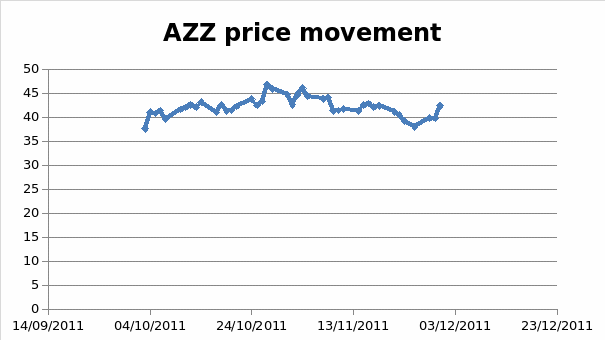
The trend for stock is as follows;
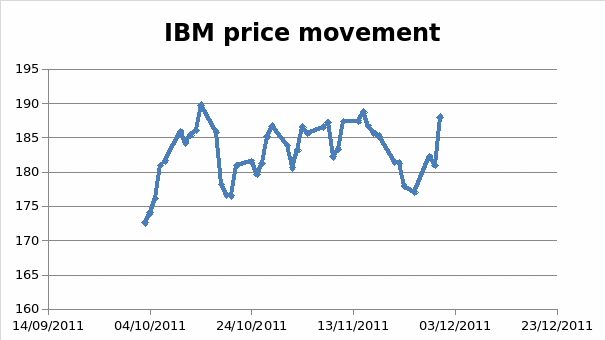
Cisco Systems, Inc stock price movement is as follows;
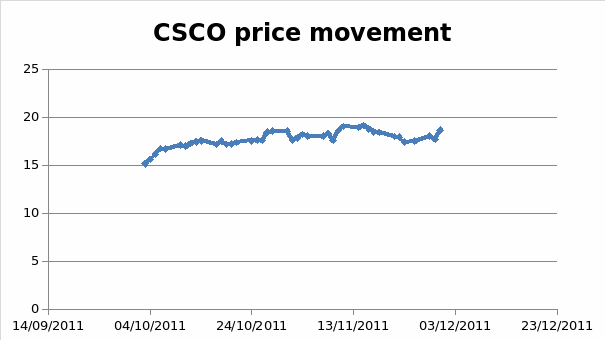
McDonald(MCD): The stock performance is as follows;
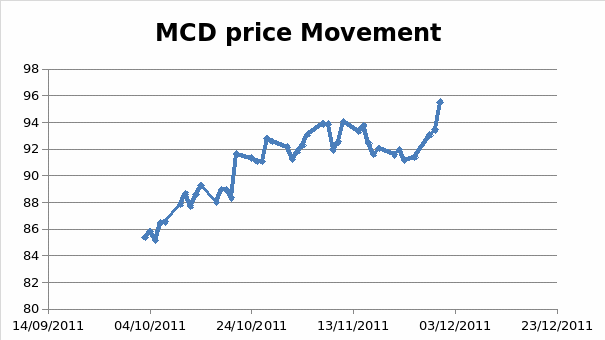
SYNNEX Corp.(SNX): The price movement stock was as follows during the time of the investment;
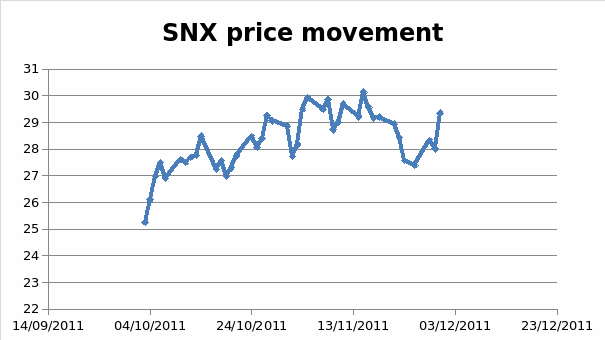
The changes in prices are up to the information that has been filtered into the market. The stocks are improving in their performance because of the information that reached the market related to their activities. There was some information that affected the stock of the company prices. The earnings information also played a major role in the pricing of stock in the market. Dividend information plays an important role.
Proclamations made at the start of the earnings period, get response that is more positive. Favorable earnings revelation stated near the beginning of the earnings period, are guided by bigger price augmentations and following earnings proclamations dates than delayed proclamations.
The timing effect connected with extreme negative earnings proclamations is in agreement with the company’s strategic impediment of dreadful news proclamations. The researcher studied the allocation and section of complex and deferred proclamations in the earnings period, and found that the companies have diminutive intent to advance news proclamations. Advanced news proclamations are disseminated equally in earnings period.
Nevertheless, companies are likely to hold up the news proclamations that circulate dreadful news in the market. The percentage of deferred proclamations augments at the conclusion of the earnings period. As forecasted, the timing effect does not subsist amid advanced dreadful news proclamations and it is the strongest amid deferred proclamations. Although these holdups only temporarily hold the bad news from the public as they are ultimately obligated to divulge the financial data. (Cataldo and Savage 89)
On the other hand, direct empirical support for a favorable revelation phase relation amid the news relating to the earnings and market return is restricted. According to Montier (22) the returns on the market are likely to be elevated in the early weeks of calendar quarters. This timing model is in favor of the attendance of a favorable association amid earnings revelation and the returns on the market.
In addition to this, Montier (28) also assesses the association amid administration earnings estimates/assistance, the returns on the market; he discovers that assistance is in general connected with the measures of collective earnings revelation, for instance, seasonal alteration in earnings and means projected inaccuracy. They furthermore discovered a number of restricted proofs of a direct connection amid guidance and market returns every month, however, this substantiation is most accommodating towards market return directing guidance.
Comparison with the market – during the holding period, the portfolio performed well in the market. If one invested at S&P 500 rate of return, one will end up with arbitrage profit of 13.44% which poor than my portfolio. This gain will be incurred if one chooses to invest in market rate (Financeyahoo. S&P 500).
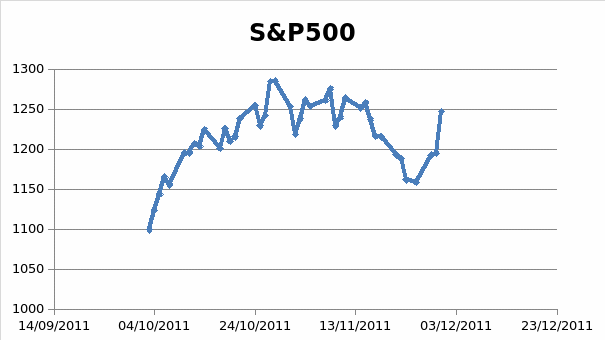
Conclusion and recommendation
This assignment has helped understand how the market works and how portfolios are constructed. When the investment was made initially, I did not understand how the portfolios are managed but this assignment has helped me improve my understanding on portfolio management. I have also learned how to use capital asset pricing model in evaluating the expected return of a portfolio.
Works Cited
Cataldo, Antony & Arline, Savage, A. A. (2000). The January Effect and Other Seasonal Anomalies: A Common Theoretical Framework. New York: Emerald Group Publishing Limited, 2000. Print
Graham, Benjamin. Securities Analysis. New York: McGraw Hill, 2004.Print.
Financeyahoo. Azz incorporated. Finance.yahoo. 2011. Web.
Financeyahoo. Cisco Systems, Inc. Finance.yahoo. 2011. Web.
Financeyahoo. International Business Machines Corp. Finance.yahoo. 2011. Web.
Financeyahoo. McDonald’s Corp. (MCD). Finance.yahoo. 2011. Web.
Financeyahoo. S&P 500. Finance.Yahoo. 2011. Web.
Financeyahoo. SYNNEX Corp. Finance.yahoo. 2011. Web.
Montier, James. Behavioral Finance: Insights into Irrational Minds and Markets. London-Wiley. 2002. Print.